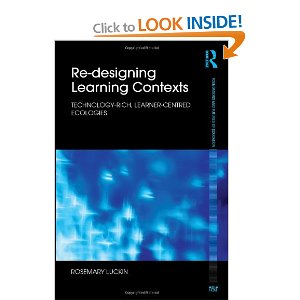Vanessa Pittard DfE, Richard Noss TEL Research Programme Director, BESA, Intellect, ALT, and Demos about research inspired technology enhanced learning to tackle challenges from teenagers’ energy consumption to social communication in a multimodal virtual environment for youngsters with Autism Spectrum Disorders. What the research says event at LKL now has a waiting list for places! Clearly people do want to talk.
Understanding you, Understanding me: is this the best we can do?
March 15, 2012 — Prof. Rose Luckin The wide-spread ownership of sophisticated computing devices such as smart phones and ipads allows mass access to social media, augmented reality and 3D virtual world applications. BUT are we making the most of these technologies to help learners communicate using all their senses? These technologies make it technically possible for people to share information about themselves and their contexts using multiple media and multi-sensory communication. This ought to mean that learners who may struggle with traditional text and image can explore new ways to express themselves. New ways to communicate what they do and don’t understand and new ways to allow others to understand more about their particular context and perspective.
The wide-spread ownership of sophisticated computing devices such as smart phones and ipads allows mass access to social media, augmented reality and 3D virtual world applications. BUT are we making the most of these technologies to help learners communicate using all their senses? These technologies make it technically possible for people to share information about themselves and their contexts using multiple media and multi-sensory communication. This ought to mean that learners who may struggle with traditional text and image can explore new ways to express themselves. New ways to communicate what they do and don’t understand and new ways to allow others to understand more about their particular context and perspective.
One of the essential ingredients for effective learning where a more knowledgeable person, such as a teacher, is helping a less knowledgeable person (or people) to learn something is that both of them share some common understanding of what the less knowledgable person currently understands. The technical possibilities for multi modal communication offered by emerging technologies should provide new ways for people to share their understanding and misunderstanding and to communicate important aspects of their personal context that may help teachers, parents, and friends to provide more effective support. But are we making enough of this potential?
I suspect we are not. To tackle challenges such as, developing a clearer understanding of how we make the most of such communication possibilities requires research rigour and energy. To develop technologies and applications that make these new formats for communication and interaction easier and effective we need industrial enterprise and innovation. To understand the needs of learners and teachers, we need to bring them into the research and design process. Most importantly of all, to improve learners’ experiences we will need research, industry, practitioners and learners to work in harmony, and that is hard to orchestrate.

 At a quick glance one might think that the title of this post means that I am thinking about the 2004 romantic drama with
At a quick glance one might think that the title of this post means that I am thinking about the 2004 romantic drama with 